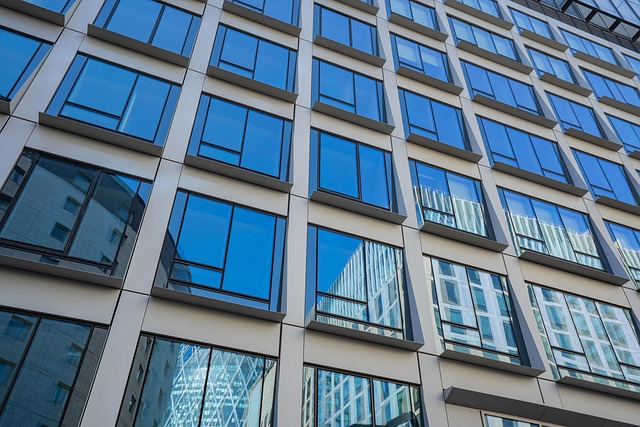Commercial air doors are vital for weatherproofing in harsh climates, acting as robust barriers against wind-driven rain. Advanced technologies like heated air doors and HVAC air curtains offer superior climate control, enhancing energy efficiency and indoor comfort. These doors, with durable construction and smart features, meet industry standards for wind resistance and water penetration resistance. They are indispensable across industries for maintaining optimal performance, reducing operational costs, and providing versatile entrance solutions.
In the face of increasingly severe weather events, robust commercial air doors are emerging as a vital component of weatherproofing strategies. Understanding wind-driven rain ingress in commercial spaces is crucial for mitigating damage and ensuring indoor environments remain dry and safe. This article explores the role of commercial air doors in combating this challenge, delving into key features, testing standards, and the wide range of benefits and applications of high-performance solutions.
- Understanding Wind-Driven Rain Ingress in Commercial Spaces
- The Role of Commercial Air Doors in Weatherproofing
- Key Features of Robust Commercial Air Door Designs
- Testing Standards for Wind Resistance in Air Doors
- Benefits and Applications of High-Performance Commercial Air Doors
Understanding Wind-Driven Rain Ingress in Commercial Spaces

Wind-driven rain ingress is a significant concern in commercial spaces, especially in regions prone to harsh weather conditions. Commercial air doors play a critical role in mitigating this issue by acting as robust entrance air barriers, preventing unwanted water and air exchange. These specialized door systems are designed to withstand high wind speeds and heavy rainfall, ensuring the interior remains protected and comfortable.
Understanding how wind-driven rain enters commercial buildings is essential when selecting appropriate solutions. Retail stores, warehouses, and industrial facilities often rely on energy-efficient barriers like climate control doors and heated air doors to maintain optimal indoor conditions. Advanced commercial entrance technology, including HVAC air curtains, offers not just weather protection but also contributes to better overall building performance through enhanced climate control.
The Role of Commercial Air Doors in Weatherproofing

Commercial air doors play a pivotal role in weatherproofing buildings, especially in regions prone to harsh climates and strong winds. These specialized door systems act as robust entrance air barriers, effectively preventing wind-driven rain ingress into warehouses, retail spaces, and industrial facilities. By employing advanced technologies like heated air doors or HVAC air curtains, commercial door systems offer not just protection but also energy efficiency.
In addition to warding off the elements, these innovative solutions contribute to climate control, ensuring interior comfort and minimizing heating or cooling costs. Retail air barriers and warehouse door heating are integral parts of modern industrial entrance solutions, enhancing operational efficiency while maintaining optimal indoor environments.
Key Features of Robust Commercial Air Door Designs

Robust commercial air doors are designed to provide a secure and efficient barrier against wind-driven rain ingress, enhancing both building performance and occupant comfort. Key features of these advanced designs include superior weatherproofing, robust construction, and innovative technology tailored for specific applications. High-quality materials like waterproof seals, reinforced frames, and strong hinges ensure longevity even in harsh environments, making them ideal for industrial entrance solutions, retail air barriers, and warehouse door heating requirements.
These doors often incorporate energy-efficient features such as advanced insulation and heated air doors to maintain optimal climate control, reducing the reliance on HVAC systems. As commercial door systems evolve with advancements in technology, new generation models offer smart controls, automatic operation, and seamless integration with building automation systems. This not only enhances operational efficiency but also contributes to overall sustainability efforts by optimizing energy usage.
Testing Standards for Wind Resistance in Air Doors

In the realm of commercial air doors, ensuring robust wind resistance is paramount to maintaining optimal performance and energy efficiency. Testing standards for these critical components are stringent, reflecting the need for effective protection against wind-driven rain ingress. Key industry organizations like ASHRAE (American Society of Heating, Refrigerating and Air-Conditioning Engineers) and ISO (International Organization for Standardization) have developed rigorous protocols to evaluate door systems’ ability to withstand extreme weather conditions. These standards cover various aspects, including air leakage rates, water penetration resistance, and structural integrity under high wind loads.
The testing process involves exposing the commercial air doors to simulated wind speeds that match or exceed local climate conditions, often in specialized wind tunnels. Additionally, engineers assess door sealing mechanisms, gaskets, and other components to guarantee minimal air infiltration. For industrial entrance solutions like heated air doors, warehouse door heating, and HVAC air curtains, the focus is on maintaining climate control while preventing rainwater intrusion. Energy-efficient barriers, including retail air barriers, must also pass these tests to ensure they not only offer robust wind resistance but also contribute to overall operational cost savings.
Benefits and Applications of High-Performance Commercial Air Doors

Commercial air doors offer numerous benefits that make them an indispensable component in various industries. Their primary advantage lies in their ability to act as robust entrance air barriers, effectively resisting wind-driven rain ingress and ensuring optimal climate control. This feature is particularly valuable in retail stores, warehouses, and industrial facilities where maintaining indoor conditions is essential for both customer comfort and product preservation.
These doors also serve as energy-efficient solutions, contributing to reduced operational costs through minimal heat loss or gain. Heated air doors, for instance, maintain interior temperatures, while HVAC (Heating, Ventilation, and Air Conditioning) air curtains provide efficient ventilation and filtration. As a result, businesses can enhance their overall operational efficiency with commercial door systems that double as advanced climate control doors. Moreover, they cater to diverse applications, making them versatile industrial entrance solutions for any establishment seeking to optimize its commercial entrance technology.
Commercial air doors play a pivotal role in safeguarding buildings against wind-driven rain ingress, offering an effective solution for weatherproofing. By understanding the challenges posed by wind and rain, and leveraging robust door designs with advanced features, building managers can ensure optimal protection. Testing standards ensure these doors meet stringent criteria, while their diverse applications demonstrate their versatility in various commercial spaces. Investing in high-performance commercial air doors is a strategic move to enhance structural integrity and create more comfortable, secure interior environments.






